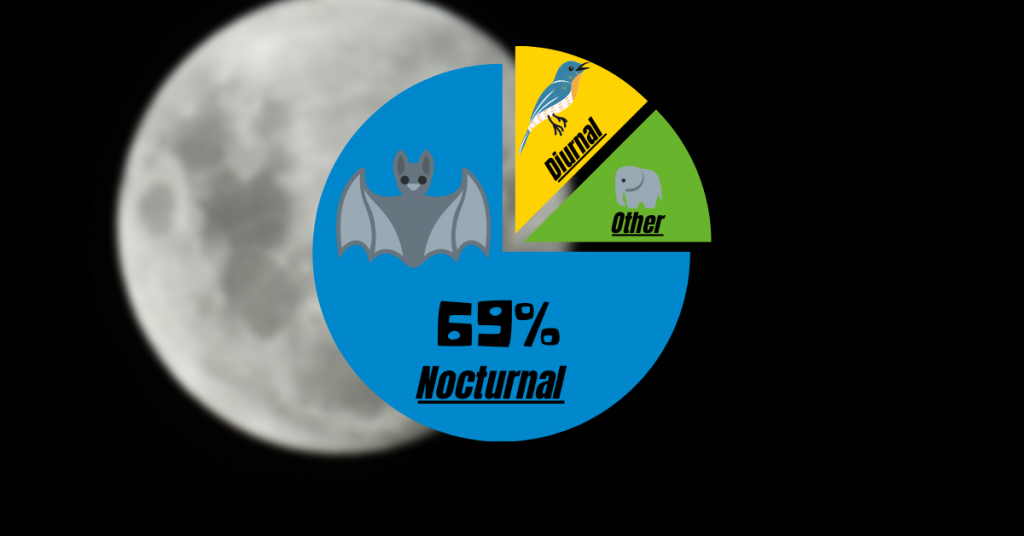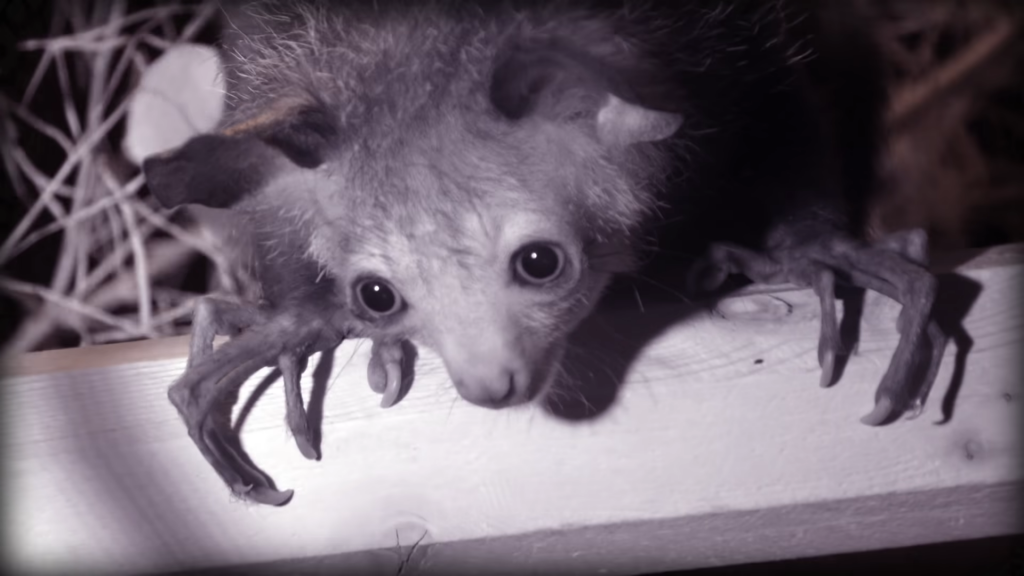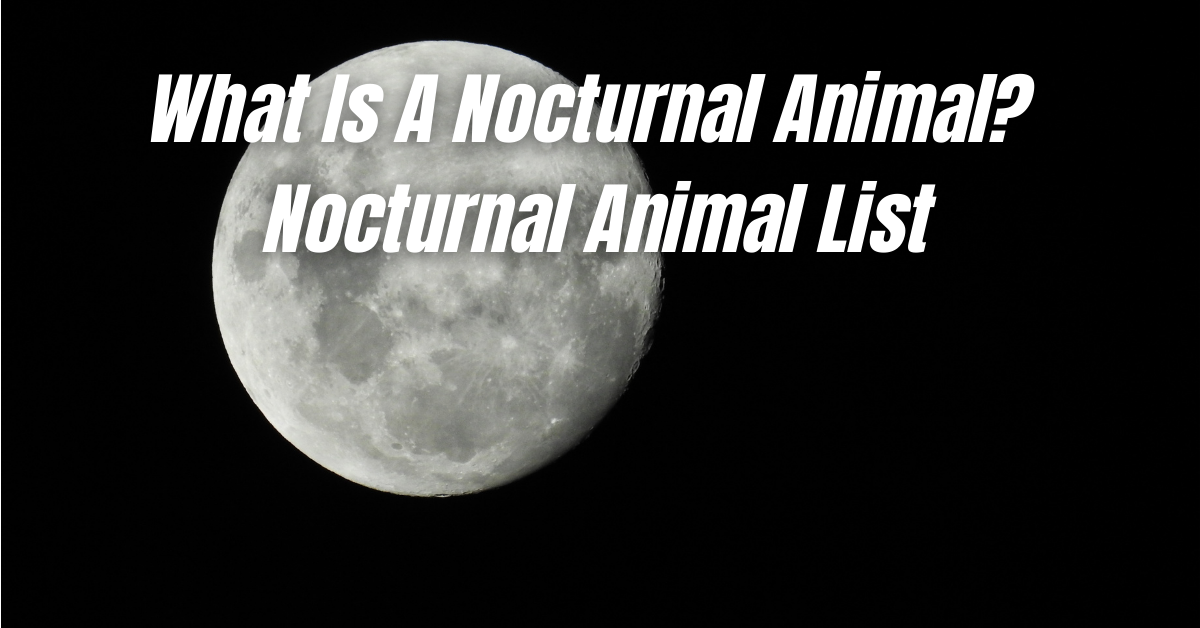Nocturnal animals are animals that are most active during the night. This is the opposite of diurnal animals, which are active during the day.
There are many reasons why an animal might be nocturnal. For example, it might be easier to find food at night, or there might be fewer predators around. Some animals are nocturnal because it helps them to avoid the heat of the day.
There are all sorts of different nocturnal animals, from bats and owls to moths and rats. Many animals that are active during the day can also be active at night, like cats and raccoons. The list goes on.
Nocturnal animals have special adaptations that help them to see in the dark and to be quiet when they move around. These adaptations help them to survive and thrive in the nighttime environment.
Table of Contents
How Many Animals Are Nocturnal?

Roughly 69% of all mammals are nocturnal, according to this study. This means that a large portion of the animal kingdom is nocturnal, and hunts/forages at night, with only 20% being diurnal.
However, it is difficult to know exactly how many nocturnal animals there are because many of them are very small and hard to find. It is also possible that some animals are nocturnal in some parts of the world but not in others.
There are thought to be more than 1,000 different species of nocturnal animals, but this is probably a very conservative estimate.
What Are the Benefits of Being Nocturnal?
There are many benefits to being nocturnal. For example, it is easier to find food at night because there are fewer animals competing for the same resources.
It is also cooler at night, so nocturnal animals can avoid the heat of the day. Additionally, there are often fewer predators active at night, so nocturnal animals can reduce their risk of being eaten.
By being nocturnal, some species of animals are allowed to coexist peacefully. For example, think of hawks and owls, two species with similar diets. Due to one being nocturnal while the other is diurnal, they don’t have to compete over prey.
Alternatively, for animals that are prey, by adapting to scavenge during the night, they are less likely to get eaten by daytime predators.
There are also some disadvantages to being nocturnal. For example, it can be more difficult to find a mate because there are fewer individuals active at night. Additionally, nocturnal animals often have to sleep during the day, which can make them more vulnerable to predators.
What Are Some Examples of Nocturnal Animals?
There are many different types of nocturnal animals, including:
- Bats: There are more than 1,200 different species of bats, and they are found all over the world. Bats use echolocation to navigate and find food in the dark. One of the most popular and favorite nocturnal animals on every list.
- Owls: There are more than 200 different species of owl, and they are found on every continent except Antarctica. Owls have excellent hearing and vision, which helps them to hunt at night.
- Moths: There are more than 160,000 different species of moths, and they are found all over the world. Moths are attracted to light, which is why you often see them flying around lamps at night.
- Rats: There are more than 60 different species of rat, and they are found all over the world. Rats are often active at night because this is when they can find food in garbage cans and other places.
- Cats: There are more than 30 different species of cat, and they are found on every continent except Antarctica. Cats are able to see in the dark, which helps them to hunt at night.
- Raccoons: There are more than 60 different species of raccoon, and they are found all over the world. Raccoons are nocturnal because this is when they can find food in garbage cans and other places.
- Bears: Certain bear species are nocturnal, such as the spectacled bear, but bears aren’t naturally nocturnal. Bears are normally crepuscular, but to avoid humans, bears have become nocturnal. Little known fact.
Some “weird” nocturnal animals list:
Here are a few of the weirder nocturnal animals in the world.
- Bandicoot: Not related to crash, bandicoots are nocturnal because this is when they can find food safely from the many predators it has.
- Skunks: There are more than ten different species of skunk, and they are found in North and South America. Skunks are nocturnal because this is when they can find food in garbage cans and other places.
- Quoll: There are more than several different species of quoll, and they are found in Australia and New Guinea. Quolls are quite odd as they can have large litters of up to 18 pups but only have six teats, meaning the others will not get to eat and therefore survive. Operating mainly at night, the Quoll eats snakes, frogs, lizards, and even echidnas, depending on the species of Quoll.
What Is the Difference Between Nocturnal and Diurnal Animals?
Nocturnal animals are active at night, while diurnal animals are active during the day. This difference is due to the fact that nocturnal animals have adapted to hunt and forage at night, while diurnal animals have adapted to hunt and forage during the day. Nocturnal animals typically have large eyes and good hearing, which helps them to see and hear their prey in the dark. Diurnal animals typically have good color vision, which helps them to see their prey during the day.
Are Dogs Nocturnal?
Dogs are not nocturnal animals, but they are crepuscular, which means that they are most active at dawn and dusk. This is because dogs are descended from wolves, which are nocturnal animals. Dogs have adapted to be more active during the day so that they can spend more time with their human companions.
In other words, your dogs love you so much that they are willing to sleep whenever you want. Awww.
What is the Largest Nocturnal Animal?

The Aye-aye is the world’s largest nocturnal primate. Its unique adaptation makes it more of a woodpecker than a primate. By tapping trees and then gnawing holes, it is able to forage grubs and other insects that it eats.
Because of its odd appearance, Aye-ayes have been seen as bad luck. This, along with habitat destruction, has caused this nocturnal species to become endangered.
When answering this question, it is important to know that a nocturnal animal can be classified as any animal that operates at night. Certain animals, like the elephant, are adapting to human activity and becoming nocturnal in certain areas of the world. This, however, does not make the elephant (or any other species) directly adapted to be nocturnal, which is what I expect those who are searching for this answer to be looking for.
Nocturnal Animal List in the UK
There are many nocturnal animals in the United Kingdom, including badgers, barn owls, bats, foxes, moles, and otters. These animals have adapted to be active at night so that they can avoid humans and other predators.
- Badgers: The largest land predator in the UK. They are quite famous across the pond with their notable black and white stripes. There are easily over 400,000 of these nocturnal animals in Europe.
- Bats: There are 1400 different species of bats in the world. It is no shock that you will find some in the UK. Bats are nocturnal because this is when they can find food, such as insects, without competing with other daytime animals.
- Barn Owls: One of the most common owls in the world, there are over 4,000 barn owls in the UK. Barn owls are nocturnal for a similar reason to bats. Less competition over prey and less predation to worry about.
- Foxes: One of the most common predators in the UK, there are over 330,000 foxes in the country.
- Moles: These small, burrowing, nocturnal animals are often considered pests. But they are an important part of the ecosystem, as they help to aerate the soil.
- Otters: There are over 15,000 otters in the UK. These nocturnal animals are often found near rivers and streams, where they hunt fish. One of the more social (in its own group) and cute nocturnal animals on the list.
While this is not an exhaustive list of nocturnal animals in the UK, it does provide a good overview of some of the more common nocturnal animals that can be found in the country.

